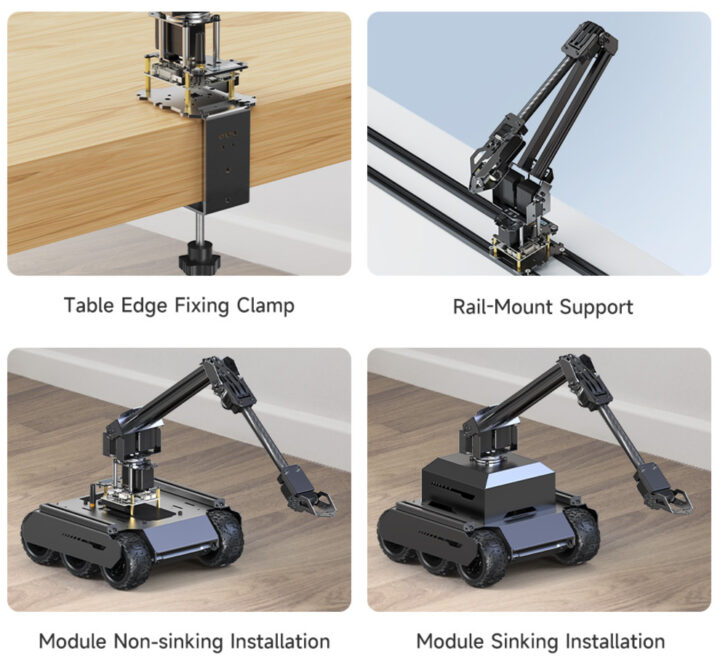Waveshare has recently launched the RoArm-M2-S and RoArm-M2-Pro ESP32 robotic arms with four degrees of freedom, or 4-DOF for short. The main difference is that the RoArm-M2-S is equipped with standard servos, while the RoArm-M2-Pro features all-metal ST3235 bus servos, adding more durability and performance.
Designed for educational and robotics applications, the 4-DOF RoArm-M2 is sturdy yet lightweight, built using carbon fiber and aluminum alloy. It can handle payloads up to 0.5kg and has a workspace diameter of 1 meter. The arm offers high precision with a 12-bit magnetic encoder and dual-drive technology for improved torque and stability. On top of that, it features a 12-bit magnetic encoder and dual-drive technology for improved torque and stability. Other features include a 360° omnidirectional base and support for both wireless (WiFi, ESP-NOW) and wired (USB) control. These features make this device suitable for various applications including industrial automation, education, research, and DIY robotics projects.
Waveshare RoArm-M2 specifications
- Degrees of Freedom (DOF): 4
- Payload 0.5kg @ 0.5m
- Workspace: 1090mm (Max, 360° omnidirectional), Vertical: 798mm (Max)
- Operating range- Base-360°, Shoulder-180°, Elbow-180°, Hand-135°/270°
- Servos
- Total servo – 5
- All-metal ST3235 bus servos, direct-drive (RoArm-M2-Pro)
- Standard servos for RoArm-M2-S (RoArm-M2-S)
- Servo speed – 40rpm (no-load, no torque limit)
- Servo torque – 30 kg.CM @12V
- Joint feedback: 12-bit 360° magnetic encoder (0.088° precision)
- Host Operation – UART/USB/ESP-NOW*/HTTP communication via JSON data format commands
- Display – 0.91-inch OLED
- Control board
- MCU module – Espressif ESP32-WROOM-32U with WiFi, and BT
- Storage – microSD card slot
- Interfaces
- I2C for OLED screens and I2C sensors
- SPI
- LiDAR Interface (supported sensor not specified)
- ST3215 Serial Bus Servo Interface
- 2x Motor Interface PH2.0 6P for motors with encoders (Group A and Group B).
- 2x Motor Interface PH2.0 2P for motors without encoders (Group A and Group B).
- 40-pin expansion header for connection to a Raspberry Pi or other host boards
- 40-pin GPIO header
- Sensors and ICs
- AK09918C 3-axis electronic compass
- QMI8658C 6-axis motion sensor
- TB6612FNG motor control chip
- ST3215 serial bus servo control circuit
- INA219 voltage and current monitoring chip.
- USB
- USB Type-C Port for power and programming the board
- USB Type-C Port for LIDAR data transmission
- Misc
- Reset button
- Download button
- Power ON/OFF button
- Power – XH2.54 power port with DC 5V voltage regulator for host computers (Raspberry Pi, Jetson Nano).
- Expansion
- EoAT customization (gripper, etc.)
- Camera mount
- Peripheral mounting rails
- Operating voltage
- 12V, 5A power supply with 2-channel supply switch
- Supports 3S Lithium batteries (NOT included)
- Dimensions
- Horizontal reach – 280.15 mm to 283.84 mm (depending on arm configuration)
- Vertical height – 236.82 mm (from the base to the top of the arm)
- Base width – 87.35 mm to 91.45 mm (including clamp mechanism)
- Clamp thickness support – Up to 86 mm
- End-effector dimensions
- Length – 67.85 mm
- Width – 5.23 mm
- Weight:
- RoArm-M2-S – 826 ±15g
- RoArm-M2-Pro – 873.3 ±15g
- Table Edge Fixing Clamp – 290g ±10g
The company mentions that its default End-of-Arm Tool (EoAT) clamp can be customized to add a degree of freedom for more complex tasks. For manual operation, the arm includes a web-based control interface, while host operation is supported via various communication modes such as UART, USB, ESP-NOW, and HTTP, using JSON data format commands (note that ESP-NOW does not support feedback information retrieval). The arm is compatible with hosts featuring a spare USB port including Raspberry Pi, Jetson Orin Nano, and PCs. Additionally, it uses a TTL serial bus servo with direct-drive joints, ensuring smooth and precise motion control.
The RoArm-M2 is open source and supports a variety of software and tools for both basic control and advanced development including a cross-platform web application to control the robotic arm from your phone, tablet, or computer, programming using the Arduino IDE, and ROS2 support for more advanced robotics features and integration with other ROS-enabled systems. Waveshare also provides documentation and tutorials which can be found on their product page or Wiki.
Previously we have written about various robotic arms including the Yahboom DOFBOT 6 DoF AI Vision robotic arm, the WLKATA Robotics Haro380 robotic arm, the ultraArm P340 robotic arm, and more. We also reviewed the myCobot 280 Pi robotic arm using Python and visual programming on the built-in Raspberry Pi 4. Feel free to check those out if you are interested in robotic arms.
The RoArm-M2-xx series ESP32 robotic arms are available on Amazon where the RoArm-M2-S costs $223.99, and on AliExpress where the RoArm-M2-S goes for $206.07 and the RoArm-M2-Pro sells for $332.11. You can also get lower prices using Black Friday/Cyber Monday 2024 AliExpress coupon codes.
Debashis Das is a technical content writer and embedded engineer with over five years of experience in the industry. With expertise in Embedded C, PCB Design, and SEO optimization, he effectively blends difficult technical topics with clear communication
Support CNX Software! Donate via cryptocurrencies, become a Patron on Patreon, or purchase goods on Amazon or Aliexpress









